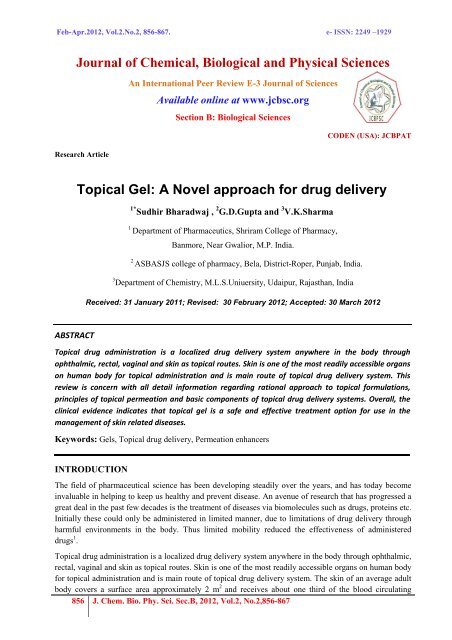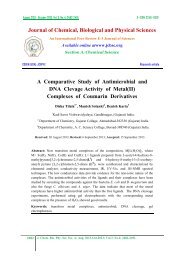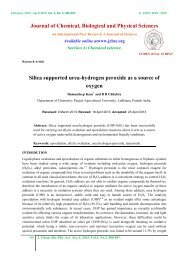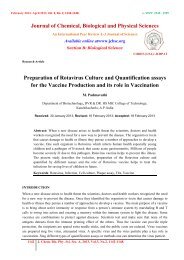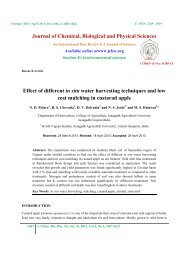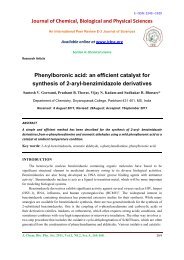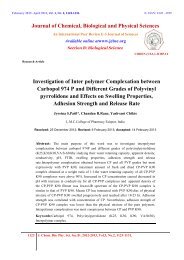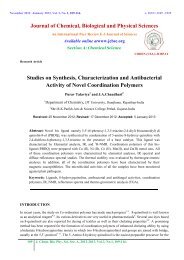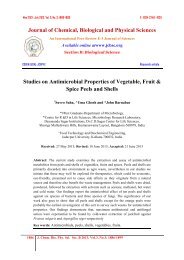Topical Gel: A Novel approach for drug delivery - Journal of ...
Topical Gel: A Novel approach for drug delivery - Journal of ...
Topical Gel: A Novel approach for drug delivery - Journal of ...
- No tags were found...
You also want an ePaper? Increase the reach of your titles
YUMPU automatically turns print PDFs into web optimized ePapers that Google loves.
Feb-Apr.2012, Vol.2.No.2, 856-867. e- ISSN: 2249 –1929<strong>Journal</strong> <strong>of</strong> Chemical, Biological and Physical SciencesAn International Peer Review E-3 <strong>Journal</strong> <strong>of</strong> SciencesAvailable online at www.jcbsc.orgSection B: Biological SciencesCODEN (USA): JCBPATResearch Article<strong>Topical</strong> <strong>Gel</strong>: A <strong>Novel</strong> <strong>approach</strong> <strong>for</strong> <strong>drug</strong> <strong>delivery</strong>1* Sudhir Bharadwaj , 2 G.D.Gupta and 3 V.K.Sharma1Department <strong>of</strong> Pharmaceutics, Shriram College <strong>of</strong> Pharmacy,Banmore, Near Gwalior, M.P. India.2ASBASJS college <strong>of</strong> pharmacy, Bela, District-Roper, Punjab, India.3 Department <strong>of</strong> Chemistry, M.L.S.Uniuersity, Udaipur, Rajasthan, IndiaReceived: 31 January 2011; Revised: 30 February 2012; Accepted: 30 March 2012ABSTRACT<strong>Topical</strong> <strong>drug</strong> administration is a localized <strong>drug</strong> <strong>delivery</strong> system anywhere in the body throughophthalmic, rectal, vaginal and skin as topical routes. Skin is one <strong>of</strong> the most readily accessible organson human body <strong>for</strong> topical administration and is main route <strong>of</strong> topical <strong>drug</strong> <strong>delivery</strong> system. Thisreview is concern with all detail in<strong>for</strong>mation regarding rational <strong>approach</strong> to topical <strong>for</strong>mulations,principles <strong>of</strong> topical permeation and basic components <strong>of</strong> topical <strong>drug</strong> <strong>delivery</strong> systems. Overall, theclinical evidence indicates that topical gel is a safe and effective treatment option <strong>for</strong> use in themanagement <strong>of</strong> skin related diseases.Keywords: <strong>Gel</strong>s, <strong>Topical</strong> <strong>drug</strong> <strong>delivery</strong>, Permeation enhancersINTRODUCTIONThe field <strong>of</strong> pharmaceutical science has been developing steadily over the years, and has today becomeinvaluable in helping to keep us healthy and prevent disease. An avenue <strong>of</strong> research that has progressed agreat deal in the past few decades is the treatment <strong>of</strong> diseases via biomolecules such as <strong>drug</strong>s, proteins etc.Initially these could only be administered in limited manner, due to limitations <strong>of</strong> <strong>drug</strong> <strong>delivery</strong> throughharmful environments in the body. Thus limited mobility reduced the effectiveness <strong>of</strong> administered<strong>drug</strong>s 1 .<strong>Topical</strong> <strong>drug</strong> administration is a localized <strong>drug</strong> <strong>delivery</strong> system anywhere in the body through ophthalmic,rectal, vaginal and skin as topical routes. Skin is one <strong>of</strong> the most readily accessible organs on human body<strong>for</strong> topical administration and is main route <strong>of</strong> topical <strong>drug</strong> <strong>delivery</strong> system. The skin <strong>of</strong> an average adultbody covers a surface area approximately 2 m 2 and receives about one third <strong>of</strong> the blood circulating856 J. Chem. Bio. Phy. Sci. Sec.B, 2012, Vol.2, No.2,856-867
Formulation...Sudhir Bharadwaj et al.through the body. An average human skin surface is known to contain, on the average 40-70 hair folliclesand 200-300 sweat ducts on every square centimeter <strong>of</strong> the skin 1 . Although skin has been dividedhistologically into the stratum corneum, the living epidermis and the dermis, collectively it can beconsidered a laminate <strong>of</strong> barrier, permeation <strong>of</strong> this laminate can occur by diffusion via:a. Transcellular penetration (across the cells)b. Intracellular penetration (between the cells)c. Transappendageal penetration (via hair follicles, sweat and sebum glands) 2, 3A myriad <strong>of</strong> medicated product are applied to the skin or readily accessible mucous membrane that insome way either augment or restore a fundamental function <strong>of</strong> a skin or pharmacologically modulate anaction in the underlined tissues. Such products are referred as topical or dermatological product 4 .1.RATIONAL APPROACH TO TOPICAL FORMULATIONS 5<strong>Topical</strong> <strong>for</strong>mulation can be used to:• Manipulate the barrier function <strong>of</strong> the skin, e.g., topical antibiotics and antibacterial help a damagedbarrier to ward <strong>of</strong>f infection, sun screening agents and the horny layer protect the viable tissues fromU.V. radiation.• Direct <strong>drug</strong>s to the viable skin tissues without using oral, systemic or other routes <strong>of</strong> therapy, e.g.,anaesthetic, anti-inflammatory, antipruritic and antihistaminics <strong>drug</strong>s are to be delivered to viableepidermis and dermis.• For skin appendage treatment, e.g., antiperspirants, exfolients and depilatories are to be delivered tothe skin appendages.• Deliver <strong>drug</strong>s <strong>for</strong> systemic treatment, e.g., transdermal therapeutic systems provide systemic therapy<strong>for</strong> motion sickness, angina and hypertension.1.1. TOPICAL GELSThe term ‘<strong>Gel</strong>’ was introduced in the late 1800 to name some semisolid material according to theirphysiological characteristics rather than molecular composition.<strong>Gel</strong>s are semisolid systems in which a liquid phase is constrained within a three dimensional polymericmatrix <strong>of</strong> natural or synthetic gums in which a high degree <strong>of</strong> physical or chemical cross linking has beenestablished 6 .The U.S.P. defines gels 7 as a semisolid system consisting <strong>of</strong> dispersion made up <strong>of</strong> either small inorganicparticle or large organic molecule enclosing and interpenetrated by liquid. The inorganic particles <strong>for</strong>m athree-dimensional ‘house <strong>of</strong> cards’ structure. <strong>Gel</strong>s consist <strong>of</strong> two-phase system in which inorganicparticles are not dissolved but merely dispersed throughout the continuous phase and large organicparticles are dissolved in the continuous phase, randomly coiled in the flexible chains. These chains areentangled with each other and shown as a single phase. The interaction between the colloidal phase,(inorganic or organic) set up the ‘structural viscosity’.Most topical gels are prepared with organic polymers, such as carbomers, that impart an aestheticallypleasing, clear, sparkling appearance to the products and are easily washed <strong>of</strong>f from the skin with water.The type <strong>of</strong> base used in <strong>for</strong>mulating a topical dermatological product greatly influences its effectiveness.Bases containing large amounts <strong>of</strong> oleaginous substances provide an emollient effect to dry irritated skin.More importantly, bases made up <strong>of</strong> non-volatile oleaginous substances (e.g. hydrocarbon bases) can <strong>for</strong>m857 J. Chem. Bio. Phy. Sci. Sec.B, 2012, Vol.2, No.2,856-867
Formulation...Sudhir Bharadwaj et al.an occlusive barrier on the skin that prevents escape <strong>of</strong> moisture from the skin into the environment. As aresult, moisture accumulates between the skin and the ointment layer that cause hydration <strong>of</strong> the stratumcorneum. Hydration <strong>of</strong> stratum corneum all ‘opening up’ <strong>of</strong> intra and inter-cellular channels and pathway<strong>for</strong> easier passage <strong>of</strong> <strong>drug</strong> molecules. Additionally, the moisture layer provides a medium <strong>for</strong> dissolution<strong>of</strong> the <strong>drug</strong> that is otherwise dispersed as fine particles in the ointment base. Since only the dissolved <strong>drug</strong>presented to the skin, as an individual molecular entity is able to enter the stratum corneum, skinocclusion generally results in enhanced percutaneous <strong>drug</strong> absorption 8 .1.1.1. Classification<strong>Gel</strong>s are classified mainly by two methods based on 9 :a. Nature <strong>of</strong> colloid phasei. Inorganic gelsii.Organic gelsb. Based on nature <strong>of</strong> solventi. Aqueous gelsii.Non aqueous gels1.1.2. <strong>Gel</strong> <strong>for</strong>ming substances 10Polymers are used to give the structural network, which is essential <strong>for</strong> the preparation <strong>of</strong> gels. <strong>Gel</strong><strong>for</strong>ming polymers are classified as follows:1. Natural polymera. Proteinsi. Collagenii. <strong>Gel</strong>atinb. Polysaccharidesi. Agarii. Alginic acidiii. Sodium or Potassium carrageenaniv. Tragacanthv. Pectinvi. Guar Gumvii. Cassia toraviii. Xanthinix. <strong>Gel</strong>lum Gum2. Semisynthetic polymersa. Cellulose derivativesi. Carboxymethyl cellulose858 J. Chem. Bio. Phy. Sci. Sec.B, 2012, Vol.2, No.2,856-867
Formulation...Sudhir Bharadwaj et al.ii. Methylcelluloseiii. Hydroxypropyl celluloseiv. Hydroxypropyl methyl cellulosev. Hydroxyethyl cellulose3. Synthetic polymersa. Carbomeri. Carbopol -940ii. Carbopol -934iii. Carbopol -941b. Poloxamerc. Polyacrylamided. Polyvinyl alcohole. Polyethylene and its co-polymers4. Inorganic substancesa. Aluminium hydroxideb. Bentonite5. Surfactantsa. Cetostearyl alcoholb. Brij – 961.1.3. AdvantagesThe topical administration <strong>of</strong> <strong>drug</strong> in order to achieve optimal cutaneous and percutaneous <strong>drug</strong> <strong>delivery</strong>has recently gained an importance because <strong>of</strong> various advantages :• To avoid gastrointestinal <strong>drug</strong> absorption difficulties caused by gastrointestinal pH and enzymaticactivity and <strong>drug</strong> interaction with food and drinks.• To avoid the first pass effect, that is, the initial pass <strong>of</strong> <strong>drug</strong> substance through the systemic and portalcirculation following gastrointestinal absorption, possibly avoiding the deactivation by digestive andliver enzymes.• Non-invasive and have patient compliance.• Less greasy and can be easily removed from the skin.• Economic.• Reduction <strong>of</strong> doses as compare to oral dosage <strong>for</strong>ms.• Localized effect with minimum side effects..1.1.4. Desirable Properties <strong>of</strong> <strong>Gel</strong>sa. It should be inert, compatible with other additives and non-toxic.859 J. Chem. Bio. Phy. Sci. Sec.B, 2012, Vol.2, No.2,856-867
Formulation...Sudhir Bharadwaj et al.b. It should be stable at storage condition.c. It should be free from microbial contamination.d. It should maintain all rheological properties <strong>of</strong> gel.e. Economical.f. It should be washable with water and free from staining nature.g. It should not affect biological nature <strong>of</strong> <strong>drug</strong>.h. It should be convenient in handling and its application.i. It should possess properties such as thixotropic, greaseless, emollient, non-staining etc.1.1.5. Desirable Properties <strong>of</strong> <strong>Gel</strong>lants 11a. It should be inert, compatible with addition and non-toxic.b. It should produce gels at low concentration.c. It should help gel <strong>for</strong>mation.d. It should be economical.e. It should be free from microbial contamination.1.2 ANATOMY OF THE HUMAN SKIN 12The skin <strong>of</strong> an average adult body covers a surface area <strong>of</strong> approximately 2 sq.m. and receives about onethird <strong>of</strong> the blood circulating through the body and serves as a permeability barrier against the topicalabsorption <strong>of</strong> various chemical and biological agents to achieve a localized pharmacological action in theskin tissues in the various <strong>for</strong>ms i.e., ointment, paste, creams, gels etc. When topical gels are applied tothe skin, the <strong>drug</strong> molecules are considered to diffuse to a target tissue and produce therapeutic effectprior to its systemic distribution <strong>for</strong> elimination. It is one <strong>of</strong> the most readily available organs <strong>of</strong> the bodywith a thickness <strong>of</strong> only a few millimeters (2.97 0.28 mm). The skin• Separates the underlying blood circulation network from the outside environment.• Serves as a barrier against physical, chemical & microbiological attacks.• Acts as a thermostat in maintaining body temperature.• Plays role in the regulation <strong>of</strong> blood pressure.• Protects against the penetration <strong>of</strong> UV rays.As skin is major factor in determining the various <strong>drug</strong> <strong>delivery</strong> aspects like permeation and absorption<strong>of</strong> <strong>drug</strong> across the dermis. The diffusional resistance <strong>of</strong> the skin is greatly dependent on its anatomy andultra structure. The skin is capable <strong>of</strong> metabolizing many substances and through its microvasculature,limits the transport <strong>of</strong> most substances into regions below the dermis. Although the flux <strong>of</strong> solutesthrough the skin should be identical <strong>for</strong> different vehicles when the solute exists as a saturated solution,the fluxes vary in accordance with the skin penetration enhancement properties <strong>of</strong> the vehicle. It isthere<strong>for</strong>e desirable that the regulatory standards required <strong>for</strong> the bio-equivalence <strong>of</strong> topical products860 J. Chem. Bio. Phy. Sci. Sec.B, 2012, Vol.2, No.2,856-867
Formulation...Sudhir Bharadwaj et al.include skin studies. Deep tissue penetration can be related to solute protein binding, solute molecularsize and dermal blood flow 12 .Fig. 1 Schematic <strong>of</strong> Skin Absorption1.2.1. Principles <strong>of</strong> <strong>Topical</strong> PermeationBe<strong>for</strong>e a topically applied <strong>drug</strong> can act either locally or systemically, it must penetrate the stratumcorneum - the skin permeation barrier. Percutaneous absorption involves passive diffusion <strong>of</strong> substancesthrough the skin. The mechanism <strong>of</strong> permeation can involve passage through the epidermis itself(transepidermal absorption) or diffusion through shunts, particularly those <strong>of</strong>fered by the relativelywidely distributed hair follicles and eccrine glands (transfollicular or shunt pathway). In the initialtransient diffusion stage, <strong>drug</strong> molecules may penetrate the skin along the hair follicles or sweat ductsand then absorbed through the follicular epithelium and the sebaceous glands. When a steady state hasbeen reached the diffusion through the intact stratum corneum becomes the primary pathway <strong>for</strong> topicalpermeation 13 .The release <strong>of</strong> a therapeutic agent from a <strong>for</strong>mulation applied to the skin surface and its transport to thesystemic circulation is a multistep process, which involves• Dissolution within and release from the <strong>for</strong>mulation• Partitioning into the skin’s outermost layer, the stratum corneum (SC)• Diffusion through the stratum corneum, principally via a lipidic intercellular pathway, (i.e., the ratelimitingstep <strong>for</strong> most compounds)• Partitioning from the stratum corneum into the aqueous viable epidermis, diffusion through theviable epidermis and into the upper dermis, and uptake into the papillary dermis and into themicrocirculation.1.2.2. Kinetics <strong>of</strong> <strong>Topical</strong> Permeation 14-16Knowledge <strong>of</strong> skin permeation kinetics is vital to the successful development <strong>of</strong> topical systems. <strong>Topical</strong>permeation <strong>of</strong> a <strong>drug</strong> involves the following steps :a. Sorption by stratum corneumb. Penetration <strong>of</strong> <strong>drug</strong> through viable epidermis861 J. Chem. Bio. Phy. Sci. Sec.B, 2012, Vol.2, No.2,856-867
Formulation...Sudhir Bharadwaj et al.c. Uptake <strong>of</strong> the <strong>drug</strong> by the capillary network in the dermal papillary layerThis permeation can be possible if the <strong>drug</strong> possesses certain physico-chemical properties. The rate <strong>of</strong>permeation across the skin (dQ/ dt) is given by:dQ / dt = P s (C d – C r ) Eq. 1Where,C d = Concentration <strong>of</strong> skin penetrant in the donar compartment (e.g., on thesurface <strong>of</strong> stratum corneum)C r = Concentration in the receptor compartment (e.g., body) respectivelyP s = Overall permeability constant <strong>of</strong> the skin tissue to the penetrantWhere,P s = ( K s D ss ) / h s Eq. 2K s is the partition coefficient <strong>for</strong> the interfacial partitioning <strong>of</strong> the penetrant molecule from a solutionmediumD ss is the apparent diffusivity <strong>for</strong> the steady state diffusion <strong>of</strong> the penetrant molecule through a thickness<strong>of</strong> skin tissuesh s is the overall thickness <strong>of</strong> skin tissues.As K s , D ss and h s are constant under given conditions, the permeability coefficient (P s ) <strong>for</strong> a skinpenetrant can be considered to be constant.From Eq.1 it is clear that a constant rate <strong>of</strong> <strong>drug</strong> permeation can be obtained only when C d >>C r i.e., the<strong>drug</strong> concentration at the surface <strong>of</strong> the stratum corneum (C d ) is consistently and substantially greaterthan the <strong>drug</strong> concentration in the body (C r ), then Eq. 1 becomes:dQ / dt = P s C s Eq. 3Permeability coefficient = (KsDss) / hs = 1 / resistance1.2.3. Physiological Factors in Percutaneous AbsorptionPhysiological factors are those that involve the properties <strong>of</strong> the barrier itself. Some important factorsare:1. Skin integrity2. Hydration3. Temperature4. Anatomic location5. Age6. Disease862 J. Chem. Bio. Phy. Sci. Sec.B, 2012, Vol.2, No.2,856-867
Formulation...Sudhir Bharadwaj et al.1.2.4. Drug Factors in Percutaneous AbsorptionThe <strong>drug</strong> factors affecting percutaneous absorption are given as follows :1. Molecular size2. Chemical nature <strong>of</strong> <strong>drug</strong>3. Partition coefficient4. Binding to the skin5. Metabolism6. Thermodynamic activity <strong>of</strong> <strong>drug</strong> in donar1.3.5. Formulation Factors in Percutaneous AbsorptionThe nature <strong>of</strong> the dosage <strong>for</strong>m is an extremely important factor in determination <strong>of</strong> skinpenetration characteristics and various <strong>for</strong>mulation factors such as :1. Occlusivity2. Drug concentration3. pH4. Solubility5. Surfactant6. Penetration enhancer1.3 BASIC COMPONENTS OF TOPICAL DRUG DELIVERY SYSTEMS 17-18<strong>Topical</strong> gel may include the following components:(A).Polymer: Polymer is an integral and <strong>for</strong>emost important component <strong>of</strong> <strong>Topical</strong> <strong>Gel</strong>. Different classes<strong>of</strong> polymeric materials have been used to achieve rate controlled <strong>drug</strong> <strong>delivery</strong>. The mechanism <strong>of</strong> <strong>drug</strong>release depends upon the physicochemical properties <strong>of</strong> the <strong>drug</strong> and polymer used in the manufacture <strong>of</strong>the device.The following criteria should be satisfied <strong>for</strong> a polymer to be used in a topical system:1. Molecular weight, glass transition temperature, chemical functionality <strong>of</strong> polymer must allowdiffusion and release <strong>of</strong> the specific <strong>drug</strong>.2. The polymer should permit the incorporation <strong>of</strong> a large amount <strong>of</strong> <strong>drug</strong>.3. The polymer should not react, physically or chemically with the <strong>drug</strong>.4. The polymer should be easily manufactured and fabricated into the desired product andinexpensive.5. The polymer must be stable and must not decompose in the presence <strong>of</strong> <strong>drug</strong> and other excipientsused in the <strong>for</strong>mulation, at high humidity conditions, or at body temperature.6. Polymers and its degradation products must be non-toxic 17 .No single material may have all these attributes, certain excipients may be incorporated to alter someproperties, e.g., Cosolvents such as ethanol, propylene glycol, PEG 400 could be added to increase <strong>drug</strong>solubility.863 J. Chem. Bio. Phy. Sci. Sec.B, 2012, Vol.2, No.2,856-867
Formulation...Sudhir Bharadwaj et al.Table -1: Useful Polymers <strong>for</strong> <strong>Topical</strong> <strong>Gel</strong>Natural polymers Semisynthetic polymers Synthetic polymersa. Proteinsi. Collagenii. <strong>Gel</strong>atinb. Polysaccharidesi. Agarii. Alginic acidiii. Sodium or Potassiumcarrageenaniv. Tragacanthv. Pectinvi. Guar Gumvii. Cassia toraviii. Xanthinix. <strong>Gel</strong>lum Guma. Cellulose derivativesi. Carboxymethylcelluloseii. Methylcelluloseiii. Hydroxypropylcelluloseiv. Hydroxypropyl methylcellulosev. Hydroxyethylcellulosea. Carbomeri. Carbopol-940ii. Carbopol-934iii. Carbopol-941b. Poloxamerc. Polyacrylamided. Polyvinyl alcohole. Polyethylene and its copolymersVarious techniques have been employed to modify the polymer properties and thus <strong>drug</strong> release rates.a. Cross-linked polymers: The higher the degree <strong>of</strong> cross-linking, the more dense the polymer andslower the diffusion <strong>of</strong> <strong>drug</strong> molecules.b. Polymer blends: Polymers have been blended on varying ratios to combine the advantages <strong>of</strong> theindividual polymers. Advantages <strong>of</strong> polymer blends include easy fabrication <strong>of</strong> devices, manipulation <strong>of</strong><strong>drug</strong> incorporating and other devices properties such as hydration, degradation rate and mechanicalstrength.(B).Drug Substance:Judicious choice <strong>of</strong> the <strong>drug</strong> plays an important role in the successful development<strong>of</strong> a topical product. The important <strong>drug</strong> properties that effect its diffusion through the device as well asthrough skin are as follows 18 :a. Physicochemical properties: Drug should have a molecular weight <strong>of</strong> less than 500 Daltons. Drug must have adequate lipophilicity. A saturated aqueous solution <strong>of</strong> the <strong>drug</strong> should have a pH value between 5 and 9. Drugs highly acidic or alkaline in solution are not suitable <strong>for</strong> topical <strong>delivery</strong>.864 J. Chem. Bio. Phy. Sci. Sec.B, 2012, Vol.2, No.2,856-867
Formulation...Sudhir Bharadwaj et al.b. Biological properties:• The <strong>drug</strong> should not be directly irritated to the skin.• The <strong>drug</strong> should not stimulate an immune reaction in the skin.• Drugs, which degrade in gastrointestinal tract or are inactivated by hepatic first pass effect, aresuitable <strong>for</strong> topical <strong>delivery</strong>.• Tolerance to the <strong>drug</strong> must not develop under the near zero order release pr<strong>of</strong>ile <strong>of</strong> topical<strong>delivery</strong>.• Drugs which have to be administered <strong>for</strong> a long time or which cause adverse effects to non-targettissue can also be <strong>for</strong>mulated <strong>for</strong> topical <strong>delivery</strong>.(C)Penetration Enhancers: These are the compounds, which promote skin permeability by altering theskin as a barrier to the flux <strong>of</strong> a desired penetrant and are considered as an integral part <strong>of</strong> most topical<strong>for</strong>mulations. To achieve and maintain therapeutic concentration <strong>of</strong> <strong>drug</strong> in the blood, the resistance <strong>of</strong>skin (stratum corneum) to diffusion <strong>of</strong> <strong>drug</strong>s has to be reduced in order to allow <strong>drug</strong> molecules to crossskin and to maintain therapeutic levels in blood. They can modify the skin’s barrier to penetration eitherby interacting with the <strong>for</strong>mulation that applied or with the skin itself.Various criteria that ideal penetration enhancers must meet are:• Ability to act specifically, reversibly and <strong>for</strong> predictable duration.• Pharmacological inertness.• Non-toxic, non-allergenic, non-irritating.• Controlled and reverse enhancing action.• Should not cause loss <strong>of</strong> body fluids, electrolytes or other endogeneous materials.• Chemical and physical compatibility with <strong>drug</strong>s and other pharmaceutical excipients with which itis used.• Following removal <strong>of</strong> the enhancer, the stratum corneum should immediately and fully recover itsnormal barrier property.• Odourless, colorless and economical and cosmetically acceptable.Enhancers increase the penetration <strong>of</strong> permeants by disrupting the structure <strong>of</strong> skin’s outer layer‘stratum corneum’ and increasing penetrant solubility. Disruption either by chemical means, may affectboth intracellular and extracellular structure. Disruption may be due to protein denaturation, fluidizationand randomization <strong>of</strong> intercellular lipids or intercellular delamination and expansion. The accelerantscause keratin to swell and leach out essential structural material from the stratum corneum, thusreducing the diffusional resistance and increasing the permeation <strong>of</strong> <strong>drug</strong>s through skin.In hydrophilic topical penetration enhancer, the miscibility and solution properties <strong>of</strong> solvent are used<strong>for</strong> the enhanced topical permeation <strong>of</strong> a water-soluble <strong>drug</strong>.Lipophilic enhancers assist the percutaneous absorption <strong>of</strong> both water soluble and oil soluble <strong>drug</strong>s. Theenhancement in the absorption <strong>of</strong> oil soluble <strong>drug</strong>s is apparently due to the partial leaching <strong>of</strong> theepidermal lipids by the enhancer, resulting in the improvement <strong>of</strong> the skin condition <strong>for</strong> wetting and <strong>for</strong>topical and transfollicular penetration.The effect <strong>of</strong> surfactant action upon the skin may change the physical stage <strong>of</strong> water in the skin in such865 J. Chem. Bio. Phy. Sci. Sec.B, 2012, Vol.2, No.2,856-867
Formulation...Sudhir Bharadwaj et al.a way as to permit greater freedom to the passage <strong>of</strong> charged hydrophilic substances. Their permeationpromoting activity is due to the action to decrease the surface tension, to improve the wetting <strong>of</strong> the skinand to enhance the distribution <strong>of</strong> <strong>drug</strong>s. Furthermore it was observed that the more hydrophilicsurfactants interact more strongly with keratin and alter permeation as compared to less hydrophilicsurfactants (long chain alcohols).Classification <strong>of</strong> permeation enhancers• Water• Sulphoxides (especially dimethylsulphoxide) and their analogues• Pyrrolidines• Fatty acid and alcohols• Azone and its derivatives• Surfactants – anionic, cationic and nonionic• Urea and its derivatives• Alcohols and glycols• Essential oils• Terpenes and derivatives• Synergistic mixtures(D). ExcipientsClass Examples Mechanism Transport PathwaySurfactants Sodium lauryl sulphate(SLS)Polyoxyethylene-9-Phospholipid acyl chainperturbationReduction mucusTranscellularParacellularlauryletherBile salts : Sodium -deoxycholate,Sodium - glycocholateSodium -taurocholateviscosityPeptidase inhibitionFatty acids Oleic acid Phospholipid acyl chain TranscellularperturbationCyclodextrins -, - and cyclodextrins Inclusion <strong>of</strong> membranecompoundsTranscellularParacellularChelatorsMethylated -cyclodextrinsEDTAComplexation <strong>of</strong> Ca 2+ opening<strong>of</strong> tight junctionsTranscellularParacellularREFERENCES1. J.R.Robinson and Lee, H.L.Vincent; Controlled Drug Delivery, 2nd Edn., Vol. 29, Marcel Dekker, Inc.,Madison Avenue, New York, 524-526.2. L.Lachman. and H.A. Lieberman; The Theory and Practice <strong>of</strong> Industrial Pharmacy, 3rd Edn., VarghesePublishing house, 1991, 536-537.3. N.K.Jain and Misra, Controlled and <strong>Novel</strong> Drug Delivery, CBS Publishers and Distributors, NewDelhi, 2005,866 J. Chem. Bio. Phy. Sci. Sec.B, 2012, Vol.2, No.2,856-867
Formulation...Sudhir Bharadwaj et al.4. G.S. Banker and C.T.Rhodes; Modern Pharmaceutics, 2nd Edn., Vol. 40, Marcel Dekker, Inc., MadisonAvenue, New York, 1990,5. K.P.R.Chowdary and M.E. Gupta;<strong>Topical</strong> Dosage Forms, The Eastern Pharmacist, 1996,6. G.S. Banker and C.T.Rhodes; Modern Pharmaceutics, 2nd Edn., Vol. 40, Marcel Dekker, Inc., MadisonAvenue, New York, 1990,7. H.C.Ansel, N.G. Popovich and Allen, V.Loyd Pharmaceutical Dosage Forms and Drug DeliverySystems, 8th Edn., B. I. Publications Pvt. Ltd., 2005, .8. R.M.Mehta; Pharmaceutics II, Vallabh Prakashan, 2000,9. H.C.Ansel, N.G. Popovich. and Allen, V.Loyd ; Pharmaceutical Dosage Forms and Drug DeliverySystems, 8th Edn., B. I. Publications Pvt. Ltd., 2005, 418.10. Ansel, H. C., Popovich, N. G. and Allen, Loyd V., Pharmaceutical Dosage Forms and Drug DeliverySystems, 8th Edn., B. I. Publications Pvt. Ltd., 2005, 419-423.11. M.F.Saettons, B.Giannacint and F. Marca; Solubilization <strong>of</strong> tropicamide by poloxamers:physicochemical data and avtivity data in rabbits and humans, Int. J. Pharm., 1988, 43, 67.12. Y.W.Chien; Transdermal therapeutic system, 2nd Edn., Vol. 29, Marcel Dekker, Inc., MadisonAvenue, New York, 524-526.13. N.K.Jain, and A.N.Misra A. N., Controlled and <strong>Novel</strong> Drug Delivery, CBS Publishers andDistributors, New Delhi, 2005, 101-106.14. Y.W.Chien,; Transdermal therapeutic system, 2nd Edn., Vol. 29, Marcel Dekker, Inc., MadisonAvenue, New York, 528-531.15. S.P.Vyas and Khar,K. Roop ;Controlled Drug Delivery, 1st Edn., Vallabh Prakashan, 2002,16. N.K.Jain, and A.N.Misra; Controlled and <strong>Novel</strong> Drug Delivery, CBS Publishers and Distributors,New Delhi, 2005,17. N.K.Jain, and A.N.Misra, Controlled and <strong>Novel</strong> Drug Delivery, CBS Publishers and Distributors, NewDelhi, 2005,18. S.P.Vyas and Khar,K. Roop ; Controlled Drug Delivery, 1st Edn., Vallabh Prakashan, 2002,*Correspondence Author: Sudhir Bharadwaj; Department <strong>of</strong> Pharmaceutics, Shriram College <strong>of</strong>Pharmacy, Banmore, Near Gwalior,M.P.India.867 J. Chem. Bio. Phy. Sci. Sec.B, 2012, Vol.2, No.2,856-867


